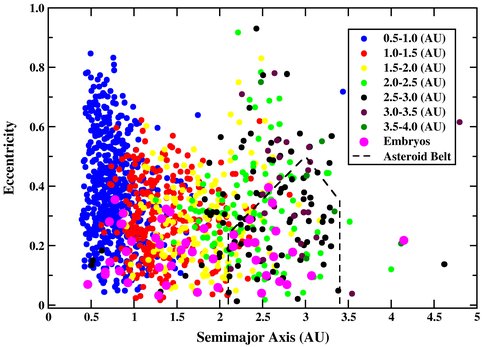2010 Annual Science Report
 University of Hawaii, Manoa
Reporting | SEP 2009 – AUG 2010
University of Hawaii, Manoa
Reporting | SEP 2009 – AUG 2010
Reconciling Giant Planet Formation With the Origin and Impact History of the Parent Bodies of Differentiated Meteorites
Project Summary
We have studied the interactions of protoplanets with planetsimals in the terrestrial region of the solar system during the formation of giant planets. We have shown that when Jupiter grows to 50 Earth-masses, it will affect the dynamics of planetesimals and their scattering to the inner asteroid belt.
Project Progress
The extraordinary number of different parent bodies of iron meteorite, and the dearth of asteroids and meteorites derived from the silicate mantles and crusts of these objects is better understood if these bodies accreted at 1-2 AU during the first 2 Myr when 26Al melted all ice-free planetesimals larger than 20-km. It has been suggested that planetary embryos at 1-2 AU dynamically excited the differentiated planetesimals and scattered their fragments into the asteroid belt where they were captured by planetary embryos. The scattering and accretion of planetesimals has occurred during the time that giant planets were growing. If the timescale for the formation of giant planets is comparable with the time of the accretion of parent bodies of iron meteorites (e.g. as short as in the recent version of the core-accretion model), or if it is as small as suggested by the disk instability scenario, the perturbation of growing giant planet(s) may affect the scattering, collision, and accretion of planetesimals. We have studied these effects in order to compare the results with meteoritic data to constrain the time of giant planet formation. We have numerically integrated the motions, collisions, and accretion of a large battery of planetesimals and planetary embryos in the region between 0.5 and 4 AU during the growth of two giant planets in orbits of Jupiter and Saturn. Results indicate that the perturbations of growing giant planets decrease the efficiency of planetesimals scattering when these objects grow to approximately 50 Earth-masses (Figure 1). For larger values of mass, this efficiency drops drastically suggesting that very short timescales for the growth of giant planets may not be favorable for models of the formation of the parent bodies of iron meteorites. We present the results of our simulations and discuss their implications for the time of giant planet formation.
Figure 1. Graph of the eccentricity of planetesimals after 10 Myr. The giant planets is a 50 Earth-mass object in the orbit of Jupiter.
Publications
- Haghighipour, N. & Scott, E.R.D. (2009). Meteorite Constraints on the Accretion of Planetesimals and Protoplanets in the Inner Solar System. 72nd Annual Meeting of the Meteoritical Society. Nancy, France.
-
PROJECT INVESTIGATORS:
-
RELATED OBJECTIVES:
Objective 1.1
Formation and evolution of habitable planets.



